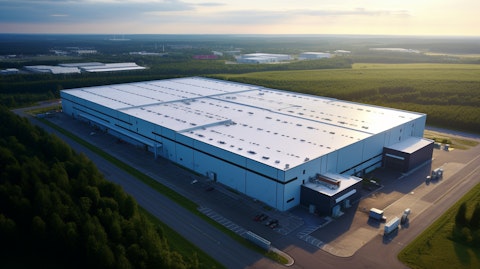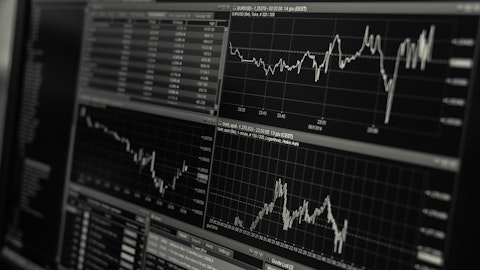STAG Industrial, Inc. (NYSE:STAG) Q3 2023 Earnings Call Transcript October 27, 2023
Operator: Ladies and gentlemen, good morning and welcome to the STAG Industrial, Inc. Third Quarter 2023 Earnings Conference Call. [Operator Instructions] As a reminder, this conference is being recorded. It is now my pleasure to introduce your host, Steve Xiarhos, Investor Relations. Please go ahead.
Steve Xiarhos: Thank you. Welcome to STAG Industrial’s conference call covering the third quarter 2023 results. In addition to the press release distributed yesterday, we have posted an unaudited quarterly supplemental information presentation on the company’s website at www.stagindustrial.com, under the Investor Relations section. On today’s call, the company’s prepared remarks and answers to your questions will contain forward-looking statements as defined in the Private Securities Litigation Reform Act of 1995. Forward-looking statements address matters that are subject to risks and uncertainties that may cause actual results to differ from those discussed today. Examples of forward-looking statements include forecasts of core FFO, same-store NOI, G&A, acquisition and disposition volumes, retention rates and other guidance, leasing prospects, rent collections, industry and economic trends and other matters.
We encourage all listeners to review the more detailed discussion related to these forward-looking statements contained in the company’s filings with the SEC and the definitions and reconciliations of non-GAAP measures contained in the supplemental information package available on the company’s website. As a reminder, forward-looking statements represent management’s estimates as of today. STAG Industrial assumes no obligation to update any forward-looking statements. On today’s call, you will hear from Bill Crooker, our Chief Executive Officer; and Matts Pinard, our Chief Financial Officer. Also here with us today is Mike Chase [ph], our Chief Investment Officer; and Steve Kimball, EVP of Real Estate Operations. We’re available to answer questions specific to the areas of focus.
I’ll now turn the call over to Bill.
Bill Crooker: Thank you, Steve. Good morning, everybody and welcome to the third quarter earnings call for STAG Industrial. We’re happy to have you with us today as we discuss our results for the quarter. Industrial leasing activity is tracking to be one of the best years on record. STAG’s portfolio is benefiting from secular tailwinds, including nearshoring, onshoring and e-commerce. Market rent growth, however, has generally experienced a degree of normalization given the changing landscape. Construction starts have steadily declined since the end of last year, primarily driven by more expensive debt capital which in many instances is difficult to obtain at affordable rates. We expect the lack of new construction starts to provide an acceleration of market rent growth as the existing supply is absorbed.
The softest part of the industrial market continues to be concentrated in big box spaces between 500,000 and 1 million square feet, particularly first generation space. In light with the potential economic uncertainty, large tenants are opting to leverage third-party logistics providers as opposed to funding expensive capital projects driving the new space. Subleasing has also been concentrated in these larger spaces. It’s important to note that STAG’s average suite size is less than 150,000 square feet and does not compete directly with these larger spaces. Deliveries are projected to be approximately 3% of the overall industrial stock this year, with nearly half of these deliveries classified as big boxes. These deliveries are expected to result in a national vacancy rate of 4.4% by year-end, a slight uptick from last quarter’s forecast.
This level of vacancy is still indicative of strong conditions. We expect market rent growth in our portfolio to be in the high single digits this year. We expect market rent growth in our portfolio for 2024 to be in the mid-single digits. The portfolio has remained resilient, due in part to our positioning within the markets we operate in. Because of the average suite size, our portfolio is strongest part of the demand in our markets. There has been a conversion rent growth between coastal and non-coastal markets which is largely driven by the secular tailwinds mentioned earlier, as well as an influx of economic investment by both the federal government and private enterprises in non-coastal markets. We are proud to report cash and GAAP leasing spreads at record highs for STAG.

As of October 24, we’ve achieved 98% of leasing we expect to accomplish in 2023 at cash leasing spreads of 30.1%. For 2024, we have addressed 37% of next year’s expected leasing, approximately 5 million square feet, achieving 30% cash re-leasing spreads. Moving to acquisitions; in the middle of this year, the bid-ask spread between sellers and buyers narrowed towards levels where transactions could begin to clear. Our acquisition volume for the third year totaled $204.3 million. This consisted of 12 buildings with cash and straight-line cap rates of 6.2% and 6.7%, respectively. Subsequent to quarter end, we acquired 3 buildings for $67.5 million and a 6.7% cash cap rate. Recently, the rapid increase in interest rates has dampened the resurgence of transaction market.
And as such, we have adjusted our guidance accordingly. In terms of dispositions this quarter, we sold 2 noncore buildings for aggregate proceeds of $28.4 million. On the development front, this quarter, we achieved substantial shell completion for our Port 290 development. This is located in Greer, South Carolina. Fortune 90 is well positioned to compete as tenant activity remains healthy in the 75,000 to 250,000 square foot suite range. We anticipate meeting our first half of 24 lease commencement assumptions in rents greater than underwriting. In addition, in August, STAG closed on 31 acres of shovel-ready dirt in the East submarket of Tampa, Florida for $9.6 million. Blue construct [ph] two warehouse distribution buildings totaling 298,000 square feet.
Anticipated to deliver in the fourth quarter of 2024, the assets will accommodate up to 3 tenants per building. This was an opportunity for STAG to add to its growing development portfolio and a high barrier to entry, strong rent growth submarket of Tampa. With that, I will turn it over to Matts who will cover our remaining results and updates to guidance.
Matts Pinard: Thank you, Bill and good morning, everyone. Core FFO per share was $0.59 for the quarter, an increase of 3.5% as compared to the third quarter of last year. Included in core FFO [ph] was a $900,000 settlement with a former tenant. This settlement resulted in an additional $0.01 of capital for the quarter and is excluded from same-store cash NOI. Cash available for distribution for the third quarter totaled $96.8 million, we have retained $71.4 million of cash flow after dividends paid this year through September 30. Leverage is just below the low end of our guidance range with net debt to annualized run rate adjusted EBITDA equal to 4.9x. Liquidity today stands at $683 million. During the quarter, we commenced 19 leases totaling 2.3 million square feet which generated record cash and straight-line leasing spreads of 39.3% and 54.2%, respectively.
We expect cash leasing spreads of approximately 30% for the year. Retention was 74.4% for the quarter and 82.5% when adjusted for immediate backfills, we achieved same-store cash NOI growth of 5.3% for the quarter and 5.3% year-to-date. We’ve experienced 3 basis points of credit loss through September 30 this year. In terms of capital market activity, on July 27, we fully settled all outstanding forward equity contracts and received $61.2 million in proceeds in the guidance we made the following updates. We increased our cash into guidance to a range of 5.25% and 5.5% for the year or 25 basis points at the midpoint. Due to the current uncertain macro environment, we have reduced our expectation for acquisitions and disposition volume for the remainder of the year.
We have decreased and narrowed the range of expected acquisition volume to range of $300 million to $350 million. Acquisition CapEx for the year are now expected to range between 6.2% and 6.3%. These ranges are driven by the material reduction in incremental acquisition volume this year and largely reflective of acquisitions made year-to-date. We decreased our disposition guidance to remain of $100 million to $125 million based on our progress through today, a decrease to the midpoint of $37.5 million. Core FFO per share guidance has increased to a range of $2.26 to $2.28 per share, an increase to the midpoint of $0.02. We have updated our retention percentage to 75% for the year. G&A expectations for the year have been decreased to a range of $48 million to $49 million.
Finally, we expect net debt to annualized run rate adjusted EBITDA to be between 5x and 5.25x. I will now turn it back over to Bill.
Bill Crooker: Thank you, Matts. Our team continues to drive value in the face of continued macroeconomic uncertainty. I’m happy about STAG’s relative position within the public REIT sector. Our defensive balance sheet coupled with the resilience of industrial fundamentals within the industrial space will allow us to be opportunistic as the landscape evolves going forward. We’ll now turn it back to the operator for questions.
See also 12 Best Automotive Stocks To Buy Now and 15 Warren Buffett Stocks That Are On Sale Now.
Q&A Session
Follow Stag Industrial Inc. (NYSE:STAG)
Follow Stag Industrial Inc. (NYSE:STAG)
Operator: [Operator Instructions] Our first question comes from Craig Mailman with Citi.
Craig Mailman: Just one clarification on in the sup [ph], when you guys put the 6.2% cash cap rate and 6.7%, are those initial cash cap rates? Or is that more of a stabilized cash cap rate?
Bill Crooker: It’s a stabilized cap rate if the lease is expiring within the first year effectively. So we had a couple of those or there’s a vacancy in there, Craig. But other than that, it’s the in place. So from a market cap rate perspective for the Q3 acquisitions, it’s around 6.7%, 6.8%, if that helps.
Craig Mailman: Okay. What would be the difference between the [indiscernible] and the initial? Would it be pretty tight or…
Bill Crooker: There’s one of our buildings, there’s some vacancy in there. So that’s obviously going to drag it down. It’s probably in the 100 basis points plus lower for a short period of time.
Craig Mailman: And then just a follow-up question, Bill, your commentary on market rent growth sounds relatively good versus some of your coastal peers this earnings season which markets do you think are really kind of the driver of only seeing kind of a downtick from maybe high single-digit rent growth this year to mid-single digit next year given some of the issues that some of the coastal markets are facing?
Bill Crooker: Yes. It’s still — it’s a similar scenario to what we had last quarter, where it’s more of a size difference than markets for us. So the bigger box are slowing and that market rent growth is probably flat to maybe even negative. And the smaller suite size is 100 — less than 150,000 square feet are still holding up really well. So where we’re seeing some weakness in bigger boxes, it’s the big box distribution markets, Indianapolis, Columbus, South Dallas, those ones will struggle with that suite size. But when you get the smaller suite sizes, all those markets are still holding up really well.
Operator: Our next question comes from John [ph] with BMO Capital Markets.
Unidentified Analyst: Just wanted to follow up on Craig’s question on the cap rates on acquisitions. So when you look at the initial cap rate and then compare it to the adjustments, to NOI that you have on Page 6 of your supplement. Even adjusting for timing, it suggests the initial NOI impact would be something closer to the sub 3% initial yield. So I’m wondering what that discrepancy is in regards [ph].
Bill Crooker: So the discrepancy is primarily related to dispositions. So we had a couple of noncore dispositions this quarter. I think one was a fixed option that was a higher cap rate that tenant [ph] had and another was a noncore, non-CBR Tier 1 market that we disposed of. So those are higher cap rates. I think when you look at that run rate adjustment, it’s a mix of acquisitions and dispositions.
Unidentified Analyst: So what were the cap rates in this position?
Bill Crooker: Matts, do you have those?
Matts Pinard: The aggregate disposition cap rate for those two, they were both 100% occupied; it was 8.8%. And again, to reiterate what Bill said, these are assets that did not have a home in our portfolio and we opportunistically dispose of these two.
Operator: Our next question comes from Vince Tibone with Green Street.
Vince Tibone: I have a few questions on the Tampa development activity. If you could just maybe provide the expected spend and incremental yield on those buildings. And then also talk about kind of what profit margins you’re targeting on these projects, given just the uncertain cap rate environment, curious how you guys thought about the market cap rate on those once they’re done.



